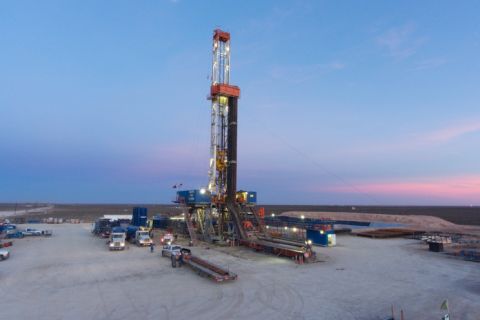Kentucky's Ohio Shale is far and away the most prolific producer among the Upper Devonian shales that extend along the western margin of the Appalachian Basin. The main shale-gas area is 3,000-square-mile Big Sandy Field in Martin, Pike, Floyd, Knott and Perry counties. Big Sandy, which sits on the eastern flank of the Cincinnati Arch, started as a bevy of separate shale-gas fields in several counties and eventually coalesced into one regional accumulation. Since its discovery in 1914, the field has produced 2.5 trillion cubic feet (Tcf) of gas from more than 10,000 wells. The greater Big Sandy area, which extends into western West Virginia, features up to 500 net feet of kerogen-rich black shale at depths to 5,000 feet. According to the U.S. Geological Survey (USGS), the shale is thermally mature and contains total organic carbon between 2% to 3%. In Pike County, Kentucky, gas contents range from 60 to 100 standard cubic feet per ton, and the gas in place stands between 5- and 10 billion cubic feet (Bcf) per section. In addition to hosting thick, mature shale, the Big Sandy area has a third element that is crucial to its productivity: it has a well-developed secondary porosity network. During several episodes of tectonic stress, joints and fractures developed within the shale, according to researchers. The Pine Mountain fault, which runs some 130 miles through eastern Kentucky from the West Virginia border to the Tennessee line, lies along the southeastern side of the gas accumulation. It is the most distal thrust of the Alleghanian orogeny, a major tectonic event that folded, faulted and thrust sediments westward during Pennsylvanian and Permian times. In eastern Kentucky, this activity intensely fractured the Devonian shales. Furthermore, part of Big Sandy overlies the Rome Trough, and flexures of the shale above this deep feature may have added to the shale's secondary porosity. There are also minor amounts of primary porosity in the silty and sandy intervals in the shale, but to be commercially productive the shale must have the added boost from jointing and fracturing. Nonetheless, even in Big Sandy the shale wells usually need a helping hand from some type of stimulation treatment. One study conducted in the early 1950s noted that only 6% of some 3,400 shale wells drilled in the field were natural producers. At that time, the preferred completion technique consisted of shooting the entire shale section with nitroglycerine; flow rates were often improved by a factor of four. During the decades of development since hydraulic fracturing techniques were developed, many variations have been tried, including nitrogen, nitrogen foam, CO2 foam and gelled water. In the early years of the field, it was not at all unusual for wells to produce at initial rates of more than 1 million cubic feet of gas per day and make more than a Bcf of gas over a 30-year lifespan. Today's wells are on the edges of the old field and are more modest, producing in the range of 200- to 450 million cubic feet of gas apiece over their lifetimes. But, at present prices, the shallow shale-gas wells are excellent moneymakers. Adding to their attractiveness is a high Btu content-between 1,100 and 1,200 per thousand cubic feet of gas-and low operating costs. And, there is still plenty of gas to go after. The USGS has recently assessed the greater Big Sandy area as containing mean undiscovered resources of 6.3 Tcf. Big Sandy spreads NGas Resources Inc., based in Lexington, Kentucky, has been developing a southward extension of Big Sandy Field for the past several years. Its properties stretch from Letcher County, at the south end of Big Sandy, down to Whitley County, Kentucky. "With the newer development that we-and a few other companies-are doing, we are extending Big Sandy," says Bill Daugherty, president and chief executive officer. The independent has been active in Kentucky since the mid-1980s, and has been interested in the possibilities around Big Sandy for some time. "We had our eye on the area since 1997," says Mike Wallen, vice president. "We developed a game plan to try to see how much of the acreage we could get under control." The area south of Big Sandy had the same geology as most of the rest of the field, but had only seen a sprinkling of shallow wells because of a lack of pipeline access and a history as an active coal-mining district. NGas stepped into the area at Straight Creek Field, located on the line dividing Bell and Harlan counties. The shale in this area is relatively thin, reaching a thickness between 150 and 200 feet. "We started on the southeastern side, acquiring acreage and drilling wells," says Daugherty. The 22,000-acre property gave NGas a foothold in the Big Sandy extension. It next approached Equitable Gas Resources and Kentucky River Coal Co., companies that owned 107,000 acres of leases north of the Pine Mountain fault in Perry, Leslie, Harlan and Letcher counties. They were willing to make a deal with NGas on this prime piece of property, known as Leatherwood, but they extracted a sizeable drilling commitment for the privilege. NGas concluded the transaction in mid-2003 and immediately drilled 25 obligatory exploratory wells throughout the leasehold. It found that the shale was productive across the entire property, and there were some particularly attractive sweet spots. "There is a lot of associated fracturing from the thrust fault, and that enhances the gas recoveries in some areas," says Wallen. In Leatherwood, the Ohio Shale ranges from 400 to 500 feet thick, expanding toward the thrust fault. Reservoir pressures were a happy surprise, landing in the 650- to 700-psi range, which was very good compared with the severely depleted pressures in the heart of Big Sandy. The company has since completed another 75 wells in the field. It has two rigs under long-term contract, and expects to drill 170 wells this year. "We plan to continue to drill heavily at Leatherwood for the next four to five years." The Leatherwood play is a continuation of Big Sandy's Devonian Shale production. "It's a great area to explore, because the shale is productive almost everywhere we drill. We look for other pay zones as well, but we know that we have the Devonian Shale to fall back on," says Daugherty. Indeed, more than half of the wells encounter pay zones in addition to the shale. The Mississippian Big Lime, Maxton Sand and Weir all can be productive, so many wells produce from commingled reservoirs. NGas sets production casing through the shale and fracture-stimulates it. "We're working with our service suppliers, testing differences between foam fracs and nitrogen fracs," says Wallen. NGas treats the shale in one large stage, using perf balls for diversion. It has been running 40,000 to 50,000 pounds of sand on a typical stage; the company is also experimenting with fracs of 60,000-plus pounds of sand and has tried a new-generation frac that uses nitrogen, sand and very little water. "Our preferred approach for fracing the shale is still up in the air; we're leaning toward straight nitrogen fracs, but in the areas with higher reservoir pressures we may go with foam fracs," he says. The company needs to evaluate the production performance for the various completion schemes; it expects to have most all of its wells producing by late third quarter. "After we see the production results, we'll choose our approach and go with it." Well costs vary, from $275,000 to $350,000 for a 4,500- to 5,000-foot air-drilled test, depending on the size of frac and the number of pay zones. "We've seen a steep increase in the price of steel during the past few years, but we've been able to manage the drilling costs." Although horizontal drilling is being used to great effectiveness in some other shale-gas plays in U.S. basins, it hasn't yet worked reliably in the Appalachians. Horizontal wells have delivered mixed results, contingent on the amount of associated fracturing that occurs in the shale. "There could very well be areas where we want to try horizontal or directional wells, but we can't yet locate the subsurface fracturing as accurately as we would like to." Indeed, eastern Kentucky wells are still drilled much as they have been throughout Big Sandy's long history. What have evolved are completion techniques, which allow thinner sections of Devonian Shale to produce at acceptable rates. "In reality, what is making the Big Sandy area attractive today are better frac jobs and $6 gas prices," says Wallen. Naturally, there are challenges to any project. Although many of the Leatherwood properties have been mined out and reclaimed, the recent upsurge in coal prices has caused a revival of interest in coal. "High coal prices have brought some previously uneconomic coal leases back into play," says Daugherty. This is an area of severed minerals, and if the coal companies have senior title they can restrict drilling in localized areas. NGas works with the coal companies on a daily basis, projecting wells in and around the mining operations. Gaining access After NGas finished its initial 25-well program at Leatherwood, it faced a dilemma. All of the wells were successful, but couldn't be produced due to lack of infrastructure. "We liked the drilling results, so we started on plans for a major pipeline project," says Wallen. Its first step was to connect the wells it had drilled at Straight Creek Field to sales. Last May, it built a five-mile section of eight-inch pipeline from Straight Creek to part of Duke Energy Gas Services Corp.'s system. That first section had to be laid across the Pine Mountain fault, a considerable barrier with its 1,400-foot elevation change. After NGas connected its first 18 wells at Straight Creek, it began work on a 25-mile, eight-inch extension to connect its shut-in Leatherwood wells to that system. Next, NGas bought most all the assets of Stone Mountain Energy Co., a local firm that had been developing a project in Harlan County on the south side of the Pine Mountain fault. Although thousands of wells produce from the shale on the north side of the fault, the south side has seen only limited activity and has very little infrastructure. Although the shale is thicker and deeper than on the other side, the south-side wells are not nearly as productive due to a lack of fracturing. Some production has been developed in the Big Lime and Weir formations, however. The Stone Mountain transaction included 113 producing wells, 23.2 billion cubic feet equivalent of proved reserves and 75,000 gross acres of leases. The wells were of particular interest to NGas because the Duke gathering system at Stone Mountain was already taking its gas from Straight Creek. "Through that acquisition, we were able to negotiate with Duke Energy and take over operations of their gathering system," says Daugherty. "Our Leatherwood gas will be going through that system into east Tennessee." At press time, NGas had just completed its pipeline expansion to Leatherwood, and during the coming months will be hooking up 150 wells to the new system. The shale wells are expected to produce into the pipeline at average rates of around 75,000 cubic feet per day, and the company is anticipating a huge jump in its production. "The extension is a key strategic development, providing us with market access into east Tennessee, and from there markets on the East Coast, for all of our Leatherwood production," says Daugherty. "It opens a new outlet for the gas north of Pine Mountain."
Recommended Reading
BP CEO: Final Permian Processing Facility to Come Online by Mid-year
2024-05-14 - BPX Energy, BP’s Houston-based subsidiary, plans to bring on its fourth and last Permian Basin processing facility in mid-year 2025, CEO Murray Auchincloss said.
APA’s Permian to Pick up Production Slack Amid Overseas Headaches
2024-02-26 - With various overseas headaches, Houston-based APA Corp. aims to boost its Permian Basin volumes and integrate its Callon Petroleum acquisition when it closes in the second quarter.
Analyst: Exxon Mobil, Pioneer Deal Close Likely ‘Imminent’
2024-05-01 - With approval from the Federal Trade Commission, Exxon Mobil could close its $59.5 million acquisition of Pioneer Natural Resources after more than six months of review.
Everywhere All at Once: Woodside CEO Touts Current Global Portfolio
2024-03-05 - Meg O’Neill, the CEO of Australian energy giant Woodside Energy, is overseeing the “next wave” of growth projects around the globe, including developments in the Gulf of Mexico, offshore Senegal and further LNG expansion.
Utah’s Ute Tribe Demands FTC Allow XCL-Altamont Deal
2024-04-24 - More than 90% of the Utah Ute tribe’s income is from energy development on its 4.5-million-acre reservation and the tribe says XCL Resources’ bid to buy Altamont Energy shouldn’t be blocked.





